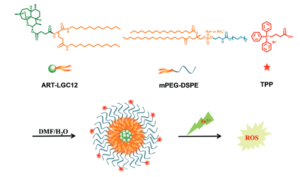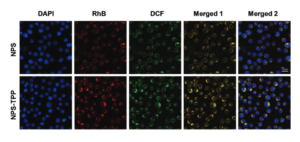Everyone knows that cancer as a disease is awful, but the side effects of currently utilized chemotherapies have their own horrors. Research into natural products as therapies have found some promising compounds, but they face barriers to practical use in patients. One particular molecule, artesunate (ART), recently showed high potential for anticancer activity when in the presence of iron. Unfortunately, ART has major problems that limit its current applicability, including low solubility in water and high instability in biologically relevant conditions.
One approach to get around these issues is to encapsulate the drug (pun intended) in a nanoparticle-based carrier. A carrier with a hydrophobic interior and hydrophilic exterior can bring higher concentrations of drugs with low solubility into a cell and protect them from deleterious conditions in the body. An additional benefit is the relative ease of incorporating targeting ligands into the particles during synthesis. This allows the drugs to only interact with specific cells or, in this specific case, the mitochondria within cells.

Figure 1. Schematic of the nanoparticle synthesis process complete with targeting ligand molecules. The anticancer agent is activated in the presence of iron.
Researchers in China have prepared approximately 200 nm nanoparticle carriers for ART (Figure 1) using triphenyl phosphonium (TPP) as a mitochondrial targeting ligand. These nanoparticles remained stable in biologically relevant conditions for a week, sufficient for in-vitro studies. The studies showed significant decreases in cancer cell growth when the nanoparticles were used compared to the ART alone. The nanoparticles with TPP on the surface showed the highest efficacy, particularly when coupled with iron treatment to activate the ART.

Figure 2. Images of cells exposed to nanoparticles with (bottom) and without (top) a targeting ligand filled with different fluorescent dyes. The increased brightness corresponds to higher uptake of the nanoparticles by the cells.
To further investigate the cell uptake pathway of the nanoparticles, the researchers added fluorescent dye molecules to the inside of the particles. Once the cells took up and ruptured the nanoparticles, the dyes were released and became visible to the researchers (Figure 2). The fluorescence was twice as great in cells exposed to the nanoparticles treated with the TPP targeting ligand, showing its value for cell uptake. The researchers also used fluorescent dyes that react with reactive oxygen species (ROSs), as their generation is how ART kills cancer cells. The in-vitro studies showed an over three-fold increase in fluorescence from reactions with ROSs which, combined with data showing higher rates of cell death, supports the increased activity of ART when combined with this nanoparticle architecture.
To find out more please read:
Zhigang Chen, Xiaoxu Kang, Yixin Wu, Haihua Xiao, Xuzi Cai, Shihou Seng, Xuefeng Wang and Shiguo Chen
Chem. Commun., 2019, 55, 4781 – 4784.
About the blogger:
Beth Mundy is a PhD candidate in chemistry in the Cossairt lab at the University of Washington in Seattle, Washington. Her research focuses on developing new and better ways to synthesize nanomaterials for energy applications. She is often spotted knitting in seminars or with her nose in a good book. You can find her on Twitter at @BethMundySci.











